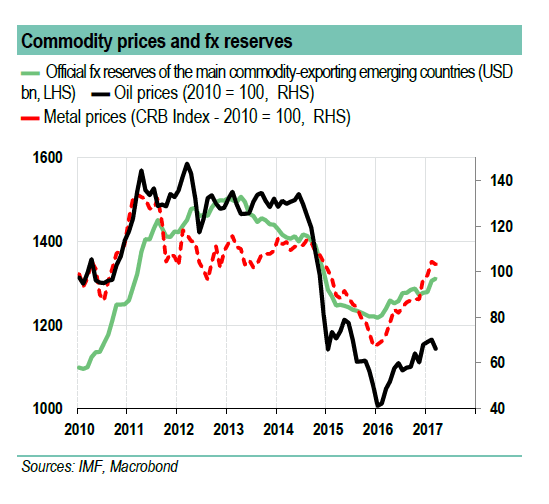The rebound in oil and metal prices has stalled since the beginning of the year. Yet world growth seems to have accelerated. Reasons to explain the pause in the commodity price recovery have to be found on the supply side. They will probably be only temporary for metals, but look more lasting for oil. For commodity-exporting emerging countries, the rebound in prices in 2016 gave them some extra breathing room. But for the most fragile economies, the turnaround needs to continue to truly restore their external liquidity.
Oil and metal prices have levelled off since the beginning of the year. Yet world growth seems to be accelerating. A temporary paradox? According to CPB estimates, world trade grew at an average annual rate of 3.1% in January, up from 2.6% in Q4 2016. In the United States, the average of the two ISM indexes for the manufacturing and services sectors peaked at 56.5 in Q1 2017, the highest level since Q3 2015, suggesting growth of close to 2.5%, compared to 1.5% in H2 2016. In the eurozone, manufacturing PMI averaged more than 55 points in Q1 2017, which is compatible with annual growth of 2%, compared to 1.8% in H2 2016.

In emerging countries, average PMI indexes increased by 1 point between Q4 2016 and Q1 2017, and are well above the 50 mark separating expansion from contraction. In March, business confidence even picked up in Mexico and Turkey. Chinese growth strengthened to 6.9% from 6.7% in H2 2016, thanks to the authorities’ stimulus programme and the upturn in exports. In India, despite demonetisation, growth remains strong, at an annual rate of 7% in Q4 2016, thanks to private consumption and public spending. The Russian economy has pulled out of recession (+0.3% year-on-year in Q4 2016). Lastly, Brazilian indicators raise hopes that the economy is stabilising, may be rebounding.
All in all, growth in emerging countries is expected to range between 4.5% and 5% in Q1 2017, while world growth ranges between 3.5% and 4%, compared to 3-3.5% in H2 2016.
Thus to understand why the rebound in oil and metal prices has stalled, we must look to supply factors. First, oil and shale gas production in the United States has picked up again. Thanks to lower operating costs, the number of wells in service surged by 88% between May 2016 and February 2017. At 8.8 million barrels/day in December 2016, production is expected to increase by 0.7 m b/d this year. Second, the November 2016 production cut deal between OPEC and certain non-OPEC countries (-1.2 million b/d out of total production of 33.1 m b/d in Q4 2016) is not being respected by all of the signing countries. On the whole, OPEC’s production target is being met (95% compliance), but this is mainly due to Saudi Arabia’s self-imposed cuts. Russia, in contrast, reduced its production by 0.1 mb/d whereas it agreed to cut production by 0.3 m b/d. All in all, supply is being reduced much less than operators initially expected.
In 2016, metal prices benefited from strong Chinese demand despite reduced production capacity in the steel sector. Infrastructure, real estate and automobiles, the three sectors that benefited from government stimulus measures, are all big metal consumers. A priori, demand remains strong. Yet the end of labour unrest at the two biggest copper mines in Chile and Indonesia, and the Indonesian government’s lifting of its nickel export ban, have weighed on prices for these two non-ferrous metals.
As far as metals are concerned, supply-side factors seem to be temporary. The factors holding down oil prices, in contrast, are probably more lasting, because US production is very responsive to price fluctuations, and Saudi Arabia is bearing almost all of the burden of production quota cuts on its own.
The rebound in commodity prices in 2016 helped boost the external liquidity of commodity-exporting countries (see chart). Yet fx reserves are still 15% below the peak of mid-2013. With the exception of Argentina, few countries facing a shortage of foreign currency have seen a true improvement in their external liquidity. Situations are still very tight in Angola, Egypt, Nigeria, and of course, Venezuela. The same is also true for the Central African Economic and Monetary Community, although mandatory liquidity ratios, which ensure the monetary zone’s viability, are still above alert thresholds. Lastly, in some cases, the rebuilding of fx reserves has gone hand in hand with the swelling of external debt. In other words, short-term liquidity is improving at the expense of medium-term solvency.
by François FAURE
